#teensy 3.2
Explore tagged Tumblr posts
Text
Oh, I did the inadvisable thing and ordered a kit to build an Ornament and Crime module. This one actually comes with the (discontinued and difficult to find) Teensy 3.2 microcontroller board required to run, though I'm seeing some info about how the same hardware can use a Teensy 4.0 instead? (I have a couple of those, so I may try one; the firmware docs are a bit vague so far.)
To explain to folks not steeped in the Eurorack scene, "Ornament and Crime" is a multipurpose digital module, something of a swiss-army knife of modular synth. It has 12 jacks — four for gate/trigger inputs, four for CV inputs, and four analog outputs — plus two rotary encoders and two pushbuttons, and an OLED screen, all run by the aforementioned Teensy. It was initially made to be something like a digital version of the Turing Machine module with built-in quantizing, but years of open-sourced development have added a lot more functions, built as interchangeable "apps" — and one of those apps, "Hemispheres", splits the device down the middle so it can simultaneously run two "applets" — to do things like various flavors of sequencing, quantization, envelope and LFO generation, random and chaotic CV generation, and drum synthesis, plus assorted other functions and utilities.
Some of my other modules are also multifunctional, but generally of narrower scope; the Sigma function generators can serve a number of analog functions when patched together or singly, and the Brains can produce any of 24 or so different voice modalities. But with the O&C, I'll be able to swap between vastly different categories of functioning, and since I have some experience with Teensy programming, it'll serve as a great development platform if I want to add functions.
2 notes
·
View notes
Text

And he wants to do this car in a kit and it's just like the Ford GT40 this is the Corvette this is like a c3 or something but the c7 or c8 is the same front end and that's what matters everybody wants a Corvette then again everybody wants to Ford GT 40 and no one can afford the Ford and we're not making that many Corvettes cuz we're stupid and really these things are fast and his stats will be different but the Chevy can go with a Chevy and the Ford can go with the Ford well that's not how they do it but this is intense what an idea and I would do a cut and I agree with it and we can start right away right now and nobody even knows where the hell they are or if they exist anymore and that's crap he used to see a few now he sees one once a month I mean it's dog due everyone's driving s***** cars and he says it's going to get worse and he can make it to sell the state which is what he wants to do solid state practically all of it to be used for a fly car the hole would work this ain't up to 3,000 which is not right but you can take it off and make the molds easier but really I understand what he's saying most of it would be like emitter proof because they change the electronics how to solid state and they don't have his reburner s*** and also the crap the exhaust is very simple and it's easy to fix the engines are a pain in the ass Tuesdays but boy would this be great so they're going to say what the stats are and we're going to have a meeting and we can he said we don't have a problem selling to our people that's that's not an issue if that's the stipulation and I don't think it's real smart to do it that way and we want to go inspire people doing it that's how you identify them and not too many at first but really we have trillions of people sitting in their stupid houses that are confident this will get them out there competent the confident too
Mac daddy
Okay we're talking about the Chevy Malibu again the base horsepower is about 220 ft pounds to 35 and the stats:
--0 to 60 in 3.2 seconds and it's slightly slower because it would be a little bit heavier because of the chassis
--quarter mile 6.8 seconds a teensy bit faster because of torque and horsepower combination
--top speed is faster and it is because of the motor it is instead of 420 of the Ford GT40 kit 480 if you did the cradle in the LS1 it is a mid-engine car at that point and the Malibu is in four wheel independent it would be 780 a little bit slower 10 mph both of these cars are extremely fast when you do it with a kit the reason is the weight is less they wait these things down with these have full cages and enclosures the GT has one no it's only a partial and it's lame and too dangerous and the Corvette has a partial to anastasis and most supercars like this this would solve the problem
Thor Freya
And I was thinking too this would solve the problem and it would be safe and you'd have safety equipment on top of it right now people are getting killed in these things are cheap and nobody wants to get one and this would change the world and I would be heading Ben would have to follow and he's saying that's fine and he can beat me because of the statistics and my grand nephew says it's because it looks a little hotter it's true too but that's his ladies car so Ben's going to get there she kicked out of me women and never notice it even though it's going to be a quadriplegic I'm going to try and do this I know what to say it's like a deal and we go ahead and start doing it and starts working somehow the Vader company is in North Carolina and we are there but the others are there too and they haven't closed their doors. We want to go ahead with this concept vehicle you need to have a V6 and you have to buy the whole kit that's the way to do it to keep it safe and so it works right and it's not going to be pricey aftermarket Corvette parts are everywhere everybody puts them in almost anything the kid itself will probably sell for 25 to 30 grand because the new car is 180,000 you can buy a brand new Malibu for $25 and put it together and it's not even it's a quarter of the price around I mean geez you can turn around and sell it for more money because it goes about 180 mph faster and they'll be famous quicker quick enough and I'll be making a bunch of money delivery we have that the whole right now is metal the shell is metal now it's not why it weighs more is they put a bunch of stupid things in it so I know what they're talking about I want to go ahead and try and get this going and I want partners from my group and his volunteering his mom because it's like the firebird and I don't know what she's scared for you can never ran near her and she says it's a drunk driver test so she wants to get involved and she's going to do it and he's going to get some sleep
Mac daddy
Me too this is an American company and I'm an American and it's our side of the family and Ken I don't know what he's doing we have to do the other side and he thinks that this car in the Corvette itself some problems been I don't know. Arnold then Arnold anyways we're talking to ben. And it's because of what Ken finds out with you so we probably want to do this
Biden
Yeah we want to do this I can't get these cars to my people and I own the company is fruitcakes want to make three a day or something I'm going to get them out of there cuz they're going to s*** everywhere but really I think that's true he's kind of thinking ahead a little you got a feeling of ken being very mad. He says he knows what to do they're going to try and steal them all day and night and it works for us we want to see that it's animal behavior they suck so damn bad they're so freaking stupid and that was Ken
Ben Arnold
He got to see it we can't get to the factories up yet they show up with armies of idiots we don't know what they're going to go down there with he shooters or nothing they're expecting them to fight and it'll still be here and it goes back to these mental patients it's a circle of stupidity
Thor Freya
Olympus
0 notes
Text

Teensy 4.0 CAN FD And LIN Bus Breakout Board For Automotive Applications
This is a CAN FD breakout board for use with the Teensy 4.0 (included in the scope of delivery). It comes with an onboard 5 VDC regulator with reverse voltage protection and a CAN FD transceiver. The LIN Bus connection is provided by the Microchip MCP2004A chip. The Teensy is a complete USB-based microcontroller development system, compatible with Arduino software and libraries. It comes in a minimal footprint, capable of implementing a great variety of projects. All programming is accomplished via the onboard USB port.
3 notes
·
View notes
Text
Piano Tiles 2 Robot | Beginner 21.079 Record
Piano Tiles 2 Robot | Beginner 21.079 Record
Robot breaks the record for Piano Tiles on the iPad. Technical details: Overhead iPhone 6+ processes video of the iPad screen at 120 fps. iPhone tracks tile speed and sends timing info via MIDI over USB through the camera connection kit. Teensy 3.2 receives tile data and sends step/direction to stepper drivers, which smash the tiles via conductive foam on brass bars.

View On WordPress
#ai#arduino#artificial intelligence#computer vision#diy#electronics#fastest#games#ipad#motor#piano tiles 2#programming#project#robot#robotics#stepper#world record
2 notes
·
View notes
Text




Testing a self made Teensy 3.2 DIY design tonight. Reflowing this one at home. This is the full SMD process. First picture is the bare board. Then solder paste is applied using a stencil. Next components are dropped onto the solder paste. This makes them stay in place, but they don't stick too well. At this point, care must be taken to not knock components around. Finally, I use a hot air soldering iron to apply heat to the paste. After all joints have melted, the board is ready to go.
1 note
·
View note
Photo
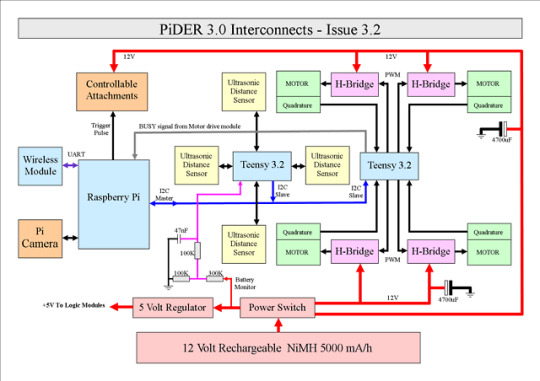
9th November 2018
Final block diagram of PiDER 3.0
I decided not to incorporate a Microbit, to reduce load on the batteries and really it would be a step too far.
The trigger pulse for the kicker/cannon/shooter will come directly from one of the Raspberry Pi GPIO pins.
Two 4700uF electrolytic capacitors have been added. One to each H-Bridge 12V power inputs to help with high current draw when the motors start or accelerate rapidly.
0 notes
Note
how do you make those light up changing eyes? is it LED panels and a raspberry pi?
The cyber head are LED matrices controlled by a 5V adafruit metro pro-trinket, while the Sans and Papyrus eyes are 1.5″ OLED screens controlled by a Teensy 3.2!
16 notes
·
View notes
Text
I've been playing with patches on my Eurorack system using the sample&hold, and as much as I love having a module that'll generate random voltages to use for pitch control, it really does point out the utility of a good quantizer.
(For the uninitiated: a quantizer restricts voltages to, well, quanta: distinct levels. The basic use case is taking a signal meant to create pitches and fixing it to just make the voltages that generate notes in a given scale. The most basic ones available just get you to the multiples of 1/12 V to give you the equal-tempered chromatic scale, but most will also let you pick out particular scales and modes, and some even do things like alternate tunings. What I would really like at this point is a module called the "Ornament and Crime", which uses the Teensy 3 microcontroller to perform a number of different functions, including tuning, quantization, creating chord progressions, and different ways of generating modulation sources like random and programmed sequences, LFOs, envelopes, and chaotic attractors. I actually have one of the increasingly rare Teensy 3.2 boards on hand to build one — technically, I have two, but I don't want to remove the one in my T.Chordstrum — but I haven't gotten to where I'm ready to do the surface-mount soldering necessary to build one.)
1 note
·
View note
Text
Week 6 - Piano Tiles 2 Robot: Existing Hardware/Existing Software/Framework Hardware
First of all, I’ve put this project into 3 categories of Audiovisual Interaction and Code because I feel as this it doesn’t cover one category more than the others. It takes bits from each one, as I’ll explain below.
A user on YouTube that goes by the name of ‘DenverFinn’, created a ‘robot’ which managed to reach the speed of 21.079 tiles per second, a lot faster than any human has (or ever will) manage to achieve, on the game Piano Tiles 2.(Existing Software). He used a Teensy 3.2 breadboard (Framework Hardware) which receives tile data and sends step/direction to stepper drivers, which smash the tiles via conductive foam on brass bars. The robot fingers are rigged to hover over an iPad, with an iPhone perched above it running 120 frames per second. The iPhone tracks tile speed and sends timing info via MIDI over USB through the camera connection kit. Along with these fingers, the robot has motors, drivers, and a controller (Existing Hardware).
DenverFinn doesn’t really give an explanation as to why he created it but I believe he just wanted to see if he could create a robot/system that could beat the record set by any human, and he succeeded.
I really like this project because it shows what sort of things can be accomplished using that we are learning how to use during lectures, and it means we can apply it to our projects if we wanted/needed to. As I’ve explained during previous posts, there is potential I could take some of this as incorporate it into my project.
youtube
0 notes
Text
Séance 4, mercredi 18 novembre 2020
Aujourd'hui, les objectifs étaient de faire fonctionner le baromètre en communication SPI puis en I2C et ensuite de faire fonctionner ensemble :
Le baromètre et l’accéléromètre
Le baromètre et le module RTC
Le baromètre et le servo-moteur
Nous avons également essayé de programmer la Teensy 3.2.
Baromètre en I2C :
Fonctionne niquel, seul défaut, un problème dans le calcul de l’altitude qui nous donne donc des valeurs erronées mais cohérentes entre elles :

Baromètre en SPI :
Fonctionne niquel, seul défaut, un problème dans le calcul de l’altitude qui nous donne donc des valeurs erronées mais cohérentes entre elles :
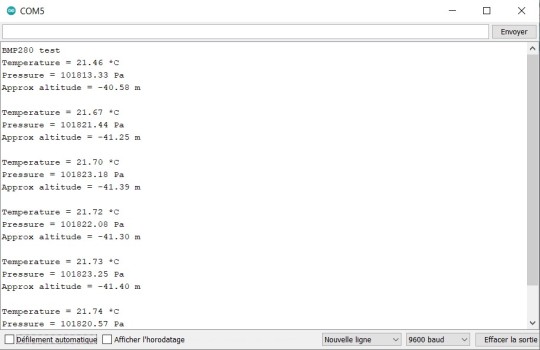
Baromètre + accéléromètre :
L’accéléromètre a fait des siennes aujourd’hui ! Impossible d’en extraire des données, il n’était même plus détecté du tout sur le bus I2C. Nous avons galéré un bon moment, puis d’un coup Lilian le touche et magie, il nous affiche des valeurs et puis plus rien, retour à la case départ. Nous avons donc décidé, après avoir passé beaucoup de temps dessus, de ne plus se prendre la tête sur l’accéléromètre aujourd’hui et sommes passés à autre chose.

Baromètre + RTC :
Nous avons bien réussi à associer ces deux capteurs ensemble, nous souhaitions associer une date et une heure à une mesure de pression et de température.
Cela nous servira pour enregistrer les données de vol sur la carte microSD et pour exploiter ces données sur un tableur, ou pour en faire des graphiques.
Voici le câblage réalisé :

Comme ça pique un peu les yeux à voir, voici le détail de branchements :
Baromètre :
SCL → pin 13
SD0 → pin 12
SDA → pin 11
CSB → pin 10
VCC → 5V
GND → 0V
RTC :
Reset → pin 5
Data → pin 6
Clock → pin 7
VCC → 5V
GND → 0V
Et voici les résultats obtenus sur le moniteur série :

On remarque que les mesures sont associées à un temps précis. Le but sera lors de l’écriture sur la carte micro SD qu’à chaque donnée un temps soit associé.
Nous pourrions ainsi étudier les durées de vol, de phases de vols, de déclenchements de parachute, ...
Baromètre + Servo-moteur :
Finalement nous avons réussi à déclencher le servo-moteur en fonction du baromètre, nous souhaitions que le servo-moteur se déclenche lorsque la pression ré-augmentait, ce qui signifie que le module est entrain de redescendre. Cela pourrait participer au déclenchement du parachute de la fusée au bon moment.
Voici la vidéo et le moniteur série : (la fonction permettant d'obtenir l'altitude sera à rectifier).

VIDÉO (voir le post “Séance 4 : Vidéo additionnelle”)
Teensy :
La Teensy 3.2 dont nous disposons peut se programmer via le logiciel Arduino mais requiert une extension.
En effet, nous avons au préalable installé Teensyduino permettant à l’IDE Arduino de reconnaître la Teensy et d’y téléverser le code.
Nous étions renseignés sur le pinout de la Teensy, le câblage était donc ok, mais les programmes que nous avons téléversés (bien que fonctionnel sur arduino uno) n’ont pas fonctionné ou alors le problème vient du fait que l’IDE Arduino n’accédait pas aux informations du capteur transmises sur le moniteur série car ce dernier était affiché vide.
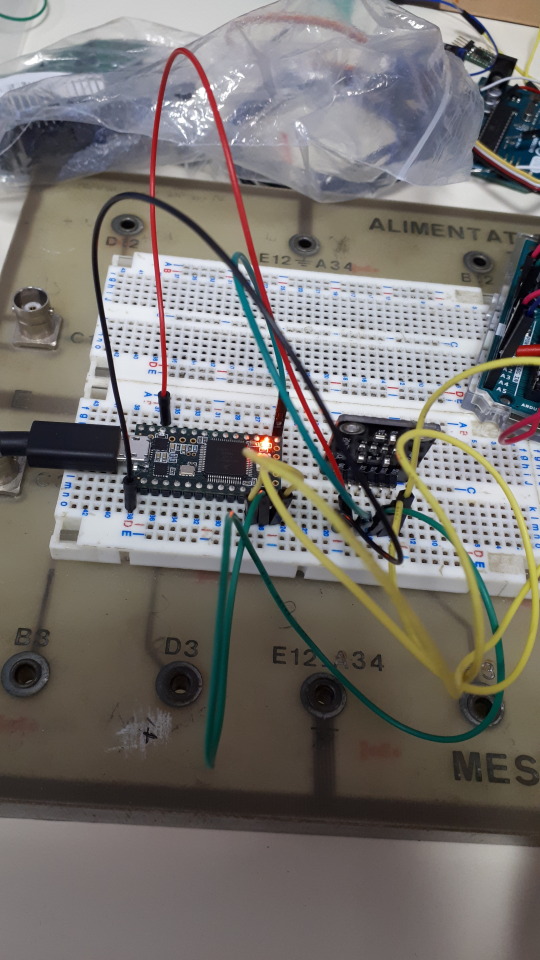
Pour déterminer si le problème vient de là, nous essaierons un programme tout simple, sans implication du moniteur série, en allumant une led par exemple.
0 notes
Text

Arduino-Compatible Teensy 4.0 CAN FD and LIN Bus Breakout Board for Automotive Applications
This is a CAN FD breakout board for use with the Teensy 4.0 (included in the scope of delivery). It comes with an onboard 5 VDC regulator with reverse voltage protection and a CAN FD transceiver. The LIN Bus connection is provided by the Microchip MCP2004A chip.
3 notes
·
View notes
Text
Greg’s Harp is an Arduino-powered robotic string instrument

Frank Piesik recently designed a robotic three-stringed instrument for his friend, Gregor, that features a unique sound and mechanical arrangement. Notes are selected by an array of 12 servos — four for each string — which pull down using a loop mechanism.

The aptly named Greg’s Harp is played by a solenoid-driven “KickUp” device that hits it from below and a small motor that continuously swipes with a “tape-propeller.” A coil assembly is also implemented to give the notes the ability to keep ringing for as long as needed (infinite sustain).
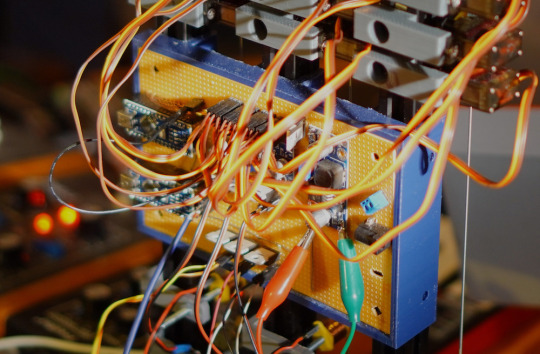
Everything is controlled by pair of Arduino Nano boards, which allow for the large number of outputs needed here, along with a Teensy 3.2 for audio processing and MIDI capabilities. You can see and hear this amazing project in the video below and more info is available in Piesik’s blog post.
youtube
Greg’s Harp is an Arduino-powered robotic string instrument was originally published on PlanetArduino
0 notes
Text
So, how’s that retirement thing going, anyway?
For the last couple of months, Prashanth Chandrasekar has been getting settled in as the new CEO of Stack Overflow. I’m still going on some customer calls and have a weekly meeting with him, but I have freed up a lot of time. I’m also really enjoying discovering just how little I knew about running medium-sized companies, as I watch Prashanth rearrange everything—for the better. It’s really satisfying to realize that the best possible outcome for me is if he proves what a bad CEO I was by doing a much better job running the company.
Even though I live in Manhattan’s premier NORC (“Naturally Occurring Retirement Community,”) I’m thinking of this time as a sabbatical, not retirement. And in fact I’m really, really busy, and, in the interest of deflecting a million questions about what I’m doing nowadays, thought I’d update my long-suffering readers here.

This adorable little fella, Cooper, is two. If your web app needs a mascot, apply within.
I’m chairman of three companies. You probably know all about Stack Overflow so I’ll skip ahead.
Fog Creek Software has been renamed Glitch, “the friendly community for building the web.” Under CEO Anil Dash, they have grown to millions of apps and raised a decent round of money to accelerate that growth. I think that in every era there has to be some kind of simplified programming environment for the quiet majority of developers who don’t need fancy administration features for their code, like git branches or multistep deployment processes; they just want to write code and have it run. Glitch is aimed at those developers.
The third company, HASH, is still kind of under the radar right now, although today they put a whole bunch of words up on their website so I guess I can give you a preview. HASH is building an open source platform for doing simulations. It’s a great way to model problems where you have some idea of how every agent is supposed to behave, but you don’t really know what all that is going to add up to.
For example, suppose you’re a city planner and you want to model traffic so that you can make a case for a new bus line. You can, sort of, pretend that every bus takes 50 cars off the road, but that’s not going to work unless you can find 50 commuters who will all decide to take your new bus line… and the way they decide is that they check if the bus is actually going to save them time and money over just driving. This is a case where you can actually simulate the behavior of every “agent” in your model, like Cities: Skylines does, and figure out the results. Then you can try thousands or millions of different potential bus routes and see which ones actually reduce traffic.
This kind of modeling is incredibly computationally intensive, but it works even when you don’t have a closed-form formula for how bus lines impact traffic, or, in general, how individual agents’ behavior affects overall outcomes. This kind of tool will be incredibly useful in far-ranging problems, like epidemiology, econometrics, urban planning, finance, political science, and a lot of other areas which are not really amenable to closed-form modeling or common “AI” techniques. (I love putting AI in “scare” “quotes”. There are a lot of startups out there trying to train machine learning models with way too little data. Sometimes the models they create just reproduce the bad decision making of the humans they are trained on. In many cases a model with simulated agents running a white box algorithm is going to be superior).
Ok, so those are the three companies I’m still working on in some way or another. That still leaves me with a couple of free days every week which I’m actually using to work on some electronics projects.

In particular, I’m really into pixel-addressable RGB LEDs, like those WS2812b and APA102-type things. Right now I’m working on designing a circuit board that connects a Teensy 3.2 controller, which can drive up to 4416 LEDs at a high frame rate, to a WizNET Ethernet adapter, and then creating some software which can be used to distribute 4416 pixels worth of data to each Teensy over a TCP-IP network in hopes of creating huge installations with hundreds of thousands of pixels. If that made any sense at all, you’re probably already a member of the LEDs ARE AWESOME Facebook group and you probably think I’m dumb. If that doesn’t make any sense, rest assured that I am probably not going to burn down the apartment because I am very careful with the soldering iron almost every time.
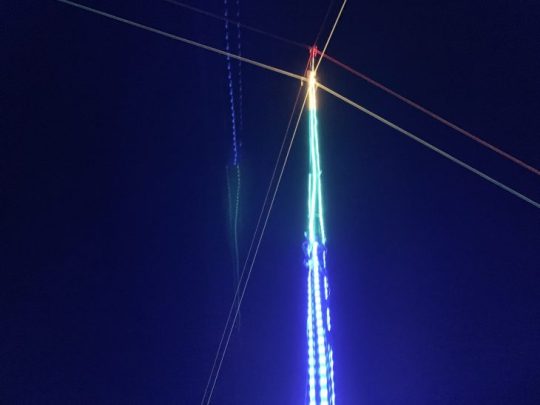
So, how’s that retirement thing going, anyway? published first on https://deskbysnafu.tumblr.com/
0 notes
Text
Connecting a Teensy 3.2 with an ESP8266
I was having trouble getting a Teensy 3.2 to communicate over Serial1 (pins 0 and 1) with an ESP8266-01S. No baud rate seemed to work: I could see the "ready" message, but there was never a reply to my commands. Recalling that pins 0 and 1 are also touch pins, I moved over to Serial 3 which does not have a touch component. This worked perfectly.
// Forked from https://kaspars.net/blog/electronics/esp8266-teensy-arduino void setup() { // Setup computer to Arduino serial Serial.begin(9600); // Setup Teensy to ESP8266 serial // Use baud rate 115200 during firmware update Serial3.begin(115200); } void loop() { // Send bytes from ESP8266 to computer if ( Serial3.available() ) { Serial.write( Serial3.read() ); } // Send bytes from computer back to ESP8266 if ( Serial.available() ) { Serial3.write( Serial.read() ); delay(100); } }
1 note
·
View note
Photo

"[P][R] ML in the embedded world"- Detail: The last couple weeks I've started experimenting with ML. As an electronic engineer I'm focus on the embedded domain and the last years on the embedded Linux domain. The last few months the semiconductor industry has turned to ML (they like to call it AI) and from now on almost all the new CPUs and MCUs are coming out with some kind of AI accelerator. The software support for that HW is still quite bad though, so there is plenty of HW and no SW, but it will get better in the future, I guess.That said, I though that it was the right time to get involved and I wanted to experiment with ML in the low embedded and the Linux embedded domain, providing some real-working examples and source code for everything. The result, was a series of 5 blog posts which I'll list here with a brief description for each one.[ML on embedded part 1]: In this post there's an implementation of a naive implementation of 3-input, 1-output neuron that is benchmarked in various MCUs (stm32f103, stm32f746, arduino nano, arduino leonardo, arduino due, teensy 3.2, teensy 3.5 and the esp8266.[ML on embedded part 2]: In this post I've implemented another naive NN with 3-input, 32-hidden, 1-output. Again the same MCUs where tested.[ML on embedded part 3]: Here I've ported tensorflow lite for microcontrollers to build with cmake for the stm32f746 and I've also ported a MNIST keras model I've found from a book to tflite. I've also created a jupyter notebook that you can hand-draw a digit and then from within the notebook run the inference on the stm32.[ML on embedded part 4]: After the results I got from part 3, I thought it would be interesting to benchmark ST's x-cube-ai framework to do 1-to-1 comparisons with tflite-micro on the same model and MCU.[ML on embedded part 5]: As all the previous posts were about edge ML, I've implemented a cloud acceleration server using a Jetson nano and I developed a simple TCP server with python that also runs inferences in the same tflite model that I've used also in part 3 & 4. Then I've written a simple firmware for the ESP8266 to send random input arrays serialized with flatbuffers to the "AI cloud server" via TCP and then get the result. I've run some benchmarks and did some comparisons with the edge implementation.Although these are more interesting for embedded engineers, I think it also fits in here.. Caption by dimtass. Posted By: www.eurekaking.com
0 notes
Text
#LSDj101 LSDj tips 2019~2020(機材用)
2019/09/28 更新
LSDj、バージョンによってRAMが空だとDON’T PANIC の画面に飛んでしまうものがあるな。
— niccolli (@niccolli) May 28, 2019
これ不思議なのは、6.8.6だと全部0x00でも0xFFでもDON’T PANIC に飛んで、曲データが入ってると正常に起動するんだよね。
— niccolli (@niccolli) May 29, 2019
おそらくこちらが参考になるかと…https://t.co/0aDvZeGQs4
— とぼけがお : 3/3 固定tweet C64曲動画 #chipvs_light_dark (@to6okegao) May 28, 2019
ソングデータが壊れる要因は様々ですが不安定なロットのUSB SMARTCARDに当たるとデータが壊れやすくなるので実機でやるなら早めにちゃんとしたカートリッジを入手したほうがいいです(最近はinsidegadgetsが比較的安価で安定したカート出してる)
— scythe (@scythe1005) May 28, 2019
The new low power version of the Gameboy 64MB Mighty Flash Cart is now available: https://t.co/HatnbDYq3r. Has 128KB SRAM instead of 32KB SRAM so suitable for LSDJ, faster saving/restoring to save slots (not able to rename the slot name as I once showed). pic.twitter.com/3i6UrxGVSX
— insideGadgets (@inside_gadgets) May 28, 2019
今更EMSのGB USB SMART CARD買うくらいなら間違いなくこっちの方がいい。Amazon価格で考えれば2枚買えるし電圧とか諸々安定性が全然違うと思うので
— scythe (@scythe1005) April 21, 2019
焼き器は一個持っとくと各種カートリッジ焼けたり普通のゲームのセーブ保存できたりできるんで損はないかと。GBメモリ?は対応してないですがhttps://t.co/GaJ1VPBTel これとかだと最新ファームウエアで行けます。ポケットカメラのセーブも持ってこれるから写真をPCに保存できるようになったり
— scythe (@scythe1005) April 22, 2019
4MBの方は載ってるICが2MBと違うので他のカートフラッシャーで焼けないので、新規で買うなら同���insidegadgetsのGBxフラッシャー買うのが多分一番いいかと。BennVennのJoeyJoebagsてフラッシャーも対応してるとは言ってるんですが4MBのカートリッジにどうもちゃんと書き込めなくて…
— scythe (@scythe1005) May 28, 2019
初期ロット…?のコンデンサ乗ってるヤツはハズレだったはず_(:3」∠)_
— [市松] (@rocketbreakers) May 28, 2019
ハズレ引いたUSB SMART CARD 64M、グリッチ起こして画面の動き不明のまま終了した記憶蘇ってきましたね…
— とぼけがお : 3/3 固定tweet C64曲動画 #chipvs_light_dark (@to6okegao) May 28, 2019
作り方はこちら。https://t.co/8QdV1gJ8bv 記事ではTeensy 2.0ですが、自分は3.2です。スケッチはそのまま使えます。 nanoloop 2.xと同期する場合はCIとの間に抵抗入れろって書いてあるけど、いくつの抵抗入れたらいいんだろう。
— 𝑷̲𝒉𝒂⃔𝒔̤̮𝒎𝒂 (@Phasma) June 23, 2017
あっ、amazonのレビューにこのROMは電池の減りがとても早いと書いてありました(^_^;)
— ツネさんざんす (@tsunech) May 21, 2019
各世代のゲームボーイの音を一番詳しく聴き比べられるの、今はやっぱこれっぽいのかな Game Boy sound comparsion (better than Herbert Weixelbaum's version) · Tutorials · Aquellex https://t.co/WwgsR3bfw8
— とぼけがお : 3/3 固定tweet C64曲動画 #chipvs_light_dark (@to6okegao) September 5, 2018
GBのアレ3種。XChanger より TRANSFERER のほうがよく使ってました。 TRANSFERERのフラッシュカートのほうが安くて、XChangerのカートを消耗させるのはもったいなかったからですw pic.twitter.com/FkcizN1rWq
— CUBIC STYLE (@cubic_style) September 30, 2018
まぁあとこれはGBCに限ったことじゃないけどCPUの状態によってノイズ乗ったりするんでアナライザーとかで見ながら状態いい奴をメイン機にするとかしたらいいんじゃないですかね。僕のメイン機は片方常にRからノイズが出てますが聴覚状わからんので今の所そのまま使ってる
— scythe (@scythe1005) July 25, 2019
結局どのGBを使えばいいんですか���題|scythe|note(ノート) https://t.co/elJsMBUXXk 暇なときちょこちょこ書いてたやつ、間違ってたら教えて
— scythe (@scythe1005) 2019年8月8日
https://t.co/bxbskTOTuy pic.twitter.com/LgeYHSG0IQ
— とぼけがお 8/14 new collab track by Klirre from Phlox (@to6okegao) 2019年8月18日
inside gadgetsのGBフラッシュカートリッジを使い始めて数ヶ月経つけどまだ一度もトラブル起きていないし、フラッシャー込みでもかなり安いからお勧め。あとこのフラッシャーでポケットカメラの写真も簡単にバックアップ出来るとの事!
— Nishioka Diddley (@diddley_sin) 2019年8月18日
それ、持ってないけどフラッシャーはいけると思う…_(┐「ε:)_👍カートはSRAMのサイズが違うからダメ
— [市松] (@rocketbreakers) 2019年8月18日
256KBフラッシュカートリッジ | CUBIC STYLE https://t.co/pso4mBNBTX #booth_pm 最新のLSDjのサイズが248KBだからギリギリ入れられると思ったけど、SAVEデータ分も含めるとオーバーする可能性があるかもしれないので見送る
— ザマ/座間野 (@zama55) 2019年8月16日
こちらは確かSRAMがなかったはずなので、そもそもセーブができませんね。ROMは焼けるはずです。 LSDjのマニュアルで言っているセーブ領域の1MBは1M"Bit"なので、これを現在一般的なByte表記に直すと128KByteになります。ややこしいとは思いますが…
— sdhizumi / S. Kudo@M3 I-15b (@sdhizumi) 2019年8月24日
GUYS I NEED HELP! I don't know what happened but i get to this rom/sav! and "recent roms" tab is cleared. I don't to load any of my other files incase the same thing ends up happening. I use #BGB plz help :#lsdj pic.twitter.com/JAYdEVZ1SK
— £ø×~ (@ZenkomanixNoobX) 2019年9月2日
use this version!! https://t.co/YQ9geEZWkP
— am near bonanza (@bananamanzero) 2019年9月2日
たまたま余ってた(たまたま?)dmg用コンデンサ��交換キットとたまたま買ってた(たまたま?)梅澤のワゴンセールコンデンサあったからカラーのコンデンサ全交換するも改善せず、もしや…と思ってNoisecancelingのコンデンサはずしたら正常動作した
— scythe@9/23 SST2019Postparty (@scythe1005) September 8, 2019
で、パスコン選定について調べているとこういうPDFが出てきたので読んでいたんだけど、パスコンには低ESL, ESRのコンデンサが適している(電流を持って行かない)らしく、セラミックコンデンサが適任らしい。 …ただまあ知ってると思うけど、こんな大容量品はほぼ無い。https://t.co/YIsWK40Txu
— sdhizumi / S. Kudo@M3 I-15b (@sdhizumi) September 9, 2019
市松氏も同様の状態らしいのでC32を増やす方向の方がよさげかもしれない。1000μFは手持ちにないからとりあえずしばらくはNFmodを外す方向でいいかな…
— scythe@9/23 SST2019Postparty (@scythe1005) September 9, 2019
2xLSDjと1xLSDj混ぜる時、1xの時は先に通信ケーブル外さなきゃいけないという戒め(LSDjモードで通信させとくと自動でSLAVEになって一緒に再生されてしまう為)https://t.co/PcmTzKFfHM
— scythe@9/23 SST2019Postparty (@scythe1005) 2019年9月23日
honestly the microcontroller can't actually be fucked just by flashing the rom chip. like it doesn't detect the cart based on what's on the rom. hold on let me help you troubleshoot
— pajamaman (@bananamanzero) 2020年2月14日
if you do want to wipe the cart completely you can do that by flashing this rom, although it's not necessary https://t.co/zJNTz1e6y7
— pajamaman (@bananamanzero) 2020年2月14日
前者はGambatteで、こっちはSameBoy。色味がそれぞれ違う感じで…うーん、個人的にはGambatteのパレット再現の方が実機GBCっぽくて好き。 pic.twitter.com/BVHhJ6uqIN
— sdhizumi / S. Kudo@M3 N-07b (@sdhizumi) 2020年3月17日
GB決め打ちならRetroarchより専用のエミュレータの方が安定して動くのかなと思いつつAndroidのエミ���レータ情勢あまり把握してないのでコレって決め打ち出せないorz 統合環境だとRETRO Xつかってましたよー、一週間くらいしか体験版起動できない有料アプリですが。 https://t.co/AMjiFEsXl0
— H/de.(TECHNOJAPAN.net) (@hide_loopcube) 2020年3月17日
Androidじゃないですが、こういうのもありますよ(LSDJ触ったことないからデモ版入れてみた)セレクトボタンと各種同時押しがretropie側で設定色々持ってるのでLRもセレクトボタン機能持たせてという変則動作ですがとりあえず動いてます。 pic.twitter.com/3LFJbrNLLj
— H/de.(TECHNOJAPAN.net) (@hide_loopcube) 2020年3月17日
0 notes